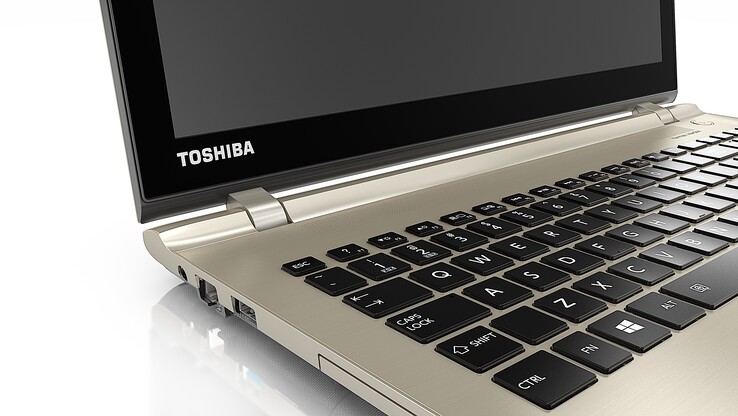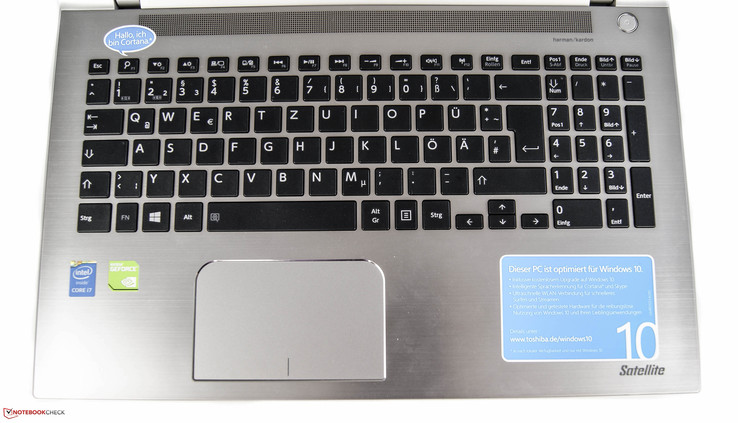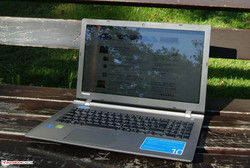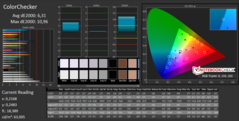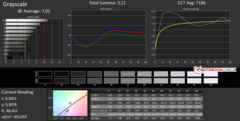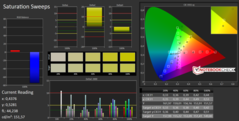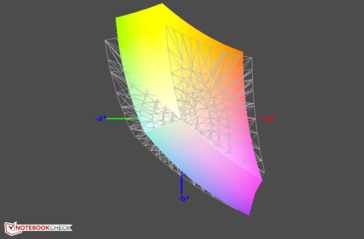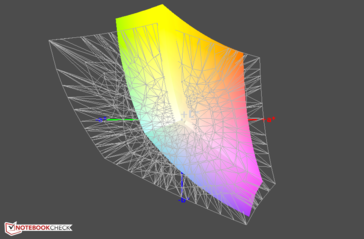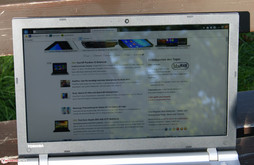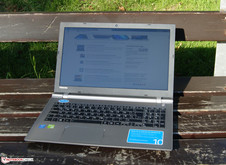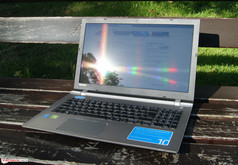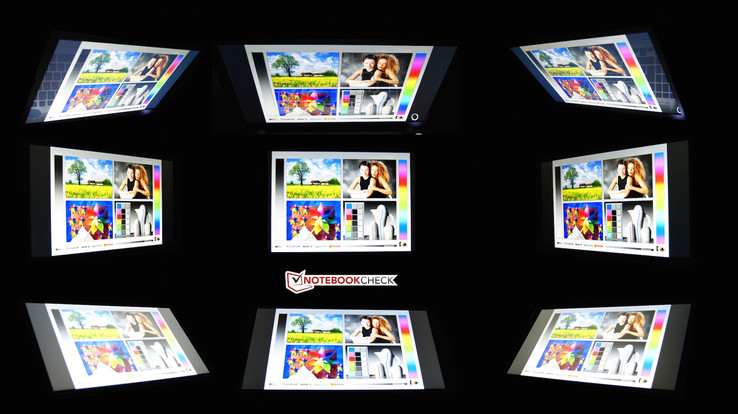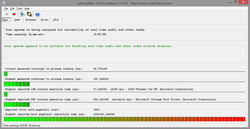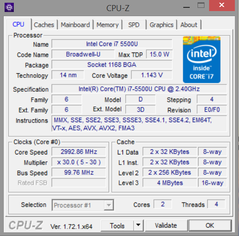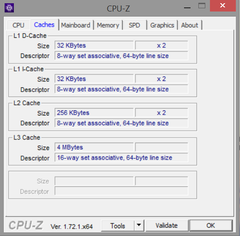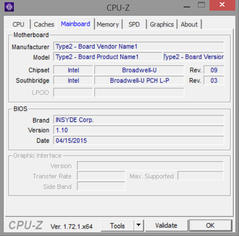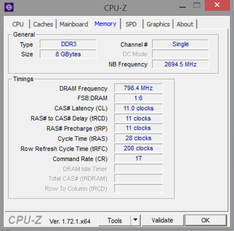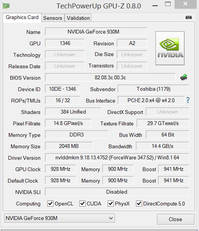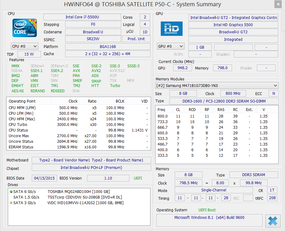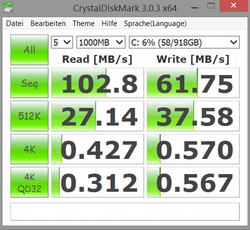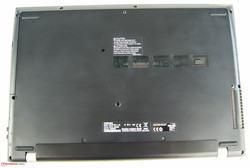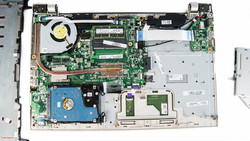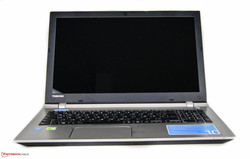Toshiba Satellite P50-C-10G Notebook Review

For the original German review, see here.
It is not the first time that we are welcoming Toshiba's Satellite P50 series in the multimedia category. The Satellite P50-A and Satellite P50t-B were the first to appear annually. Although the basic idea remains the same, there are several differences, both inside and out. Our Satellite model aims to fuse performance and mobility. The combination of a frugal yet fast Intel Core i7-5500U, a dedicated NVIDIA GeForce 930M, 8 GB of working memory and a 1 TB HDD should make this possible. Although the manufacturer lists other configurations, they do not have a price tag yet. A 4K screen option, AMD R6 graphics unit, and diverse SSD and HDD options are among these. The recommended price of our configuration is approximately 1250 Euros (~$1386).
We have selected some representatives as points of reference to competing models during our tests. Dell's Inspiron 15-7548 is equipped with an identical CPU, but twice the working memory and an AMD R7 M270 graphics card. An alluring detail: With a price of 1200 Euros (~$1330), it features a 3840x2160 pixel touchscreen. The next contender in our round is MSI's PE60 with a price tag of 1130 Euros (~$1253). Our test configuration features a considerably stronger NVIDIA GeForce GTX 960M, which might make casual gamers curious. To complete our test lineup, we have opted for a more expensive comparison model and added the 1800 Euros (~$1995) HP's EliteBook 850 G2 as a touchstone.
Case
Plastic and aluminum parts are the materials of choice. Similar to other laptops of this series, the back and keyboard unit feature a brushed aluminum plate. Apart from some exceptions, the rest of the casing has to be satisfied with matte-black plastic. Unfortunately, we noticed minor inconsistencies in the build. The gap between the two components is slightly larger on the keyboard's left than on the right. Furthermore, the lid dents easily on the back, and the battery has too much room in its compartment. The screen's opening resistance is a bit too flimsy and could quickly lead to unintentional rocking. The feel of the rounded corners is generally pleasing. The slim, 23 mm (~0.9 in) laptop, weighting approximately 2.2 kg (~4.8 lb) is a good companion.
It soon becomes evident that more effort has to be invested in maintenance on the underside. Neither the battery nor individual components can be removed via the maintenance hatches. 12 screws have to be released for accessing the innards. Unfortunately, there are no opening instructions. The battery is the easiest component to remove, after releasing two screws. Some dismantling videos can be found on Toshiba's YouTube channel.
Connectivity
The diversity of interfaces in our review sample covers only the most common standard ports. On a positive note, only USB 3.0 ports are installed rather than a mix with USB 2.0 ports. The left side houses an Ethernet jack and one USB port, peripherals that are permanently connected. Temporary devices will probably find their place on the right. The interfaces are centered and easy to reach. However, the work area on the laptop's right might be obstructed slightly when a monitor is permanently connected via HDMI.
Communication
Intel's dual-band Wireless AC 3160 module takes care of Wi-Fi connections. Apparently it can achieve up to 433 Mbps. The average download speed is determined in the author's personal setup. The network hard drive was connected via a Speedport W 724 V router. An approximate throughput rate is to be ascertained via a 5 GB download performed several times. The router is one story below the laptop, and had to overcome a straight distance of 5 meters (~16.4 ft). Alienware's R15 model with a Killer Wireless 1525 adapter is used for comparison. Toshiba's review sample settled between 18 and 21 MB/s in the runs. Alienware's comparison model achieved roughly 5 - 6 MB/s more. A connection via the Ethernet port speeds up the download due to a 1 Gbit connection.
Accessories
Our review sample comes without any product-specific accessories. Only bags and plugs are found on the manufacturer's website.
Maintenance
As mentioned before, there are no maintenance hatches on the underside. The few screws that fix the battery and the DVD drive can be removed quickly. After releasing the 12 screws and a little dexterity, the base unit can be lifted. However, care is needed to prevent cracking the thin plastic or breaking the clips. All repairs can be performed after removal. At a first glance, accessing the components seems quite user-friendly. It is even possible to replace or clean the fan without obstructions.
Warranty
A 24-month manufacturer warranty is included ex-factory. An on-site pick-up service is applicable as long as the device is in Germany or Austria. It is possible to extend the warranty to three or four years. However, Toshiba does not state any prices on the product page. Furthermore, the manufacturer offers a data recovery service for a period of three years.
Input Devices
Keyboard
A black chiclet keyboard with a number pad is installed in our review sample. The number pad keys are slightly narrower than the other keys. The lettering on the keys is quite generous. Since there is no keyboard backlight, only adept fingers will find their way over the keyboard at night. The keys' drop is relatively short but crisp and do not yield too much at the sides. The typing feel is generally acceptable, but will not quite satisfy the needs of a real office worker. We have to criticize the arrow F keys, which not only have a different drop, but also do not respond to light pressure.
Touchpad
The roughened surface of the 10.6 x 6.5 cm (~4.17 x 2.6 in) touchpad provides good gliding properties. Inputting is always smooth and without delays. Even multitouch gestures like scrolling websites are no problem. Although zooming on websites is slightly delayed, this is very likely due to software support. Like most touchpads, the problem zones are found in the corners. Inputting is rather sporadic there. The drop of the keys incorporated in the lower part decreases toward the center. However, the input device can replace mouse use for prolonged periods.
Display
The manufacturer has installed a screen from LG in its Satellite P50. The Full HD screen with a resolution of 1920x1080 pixels has an average brightness of 301 cd/m². This brightness rate is now considered the average for this price range. Although the glossy screen will not suit everyone, Toshiba does not offer a matte alternative. A look at the competition, for example MSI's PE60, will be necessary here. Unfortunately, the brightness drops to 245 cd/m² in battery mode. The illumination of 86% could be better. Minor screen bleeding is also visible in the screen's lower area.
| |||||||||||||||||||||||||
Brightness Distribution: 86 %
Center on Battery: 245 cd/m²
Contrast: 1075:1 (Black: 0.28 cd/m²)
ΔE ColorChecker Calman: 6.31 | ∀{0.5-29.43 Ø4.78}
ΔE Greyscale Calman: 7.02 | ∀{0.09-98 Ø5}
84% sRGB (Argyll 1.6.3 3D)
55% AdobeRGB 1998 (Argyll 1.6.3 3D)
61.2% AdobeRGB 1998 (Argyll 3D)
83.8% sRGB (Argyll 3D)
64.3% Display P3 (Argyll 3D)
Gamma: 3.11
CCT: 7186 K
| Toshiba Satellite P50-C-10G GeForce 930M, 5500U, Toshiba MQ02ABD100H | MSI PE60-2QEi581 GeForce GTX 960M, 4210H, HGST Travelstar 7K1000 HTS721010A9E630 | Dell Inspiron 15-7548 Radeon R7 M270, 5500U, Liteon IT LCS-256L9S-11 | HP EliteBook 850 G2 J8R68EA Radeon R7 M260X, 5500U, Samsung SSD PM851 256 GB MZ7TE256HMHP | |
|---|---|---|---|---|
| Display | 12% | -7% | ||
| Display P3 Coverage (%) | 64.3 | 67.6 5% | 56.5 -12% | |
| sRGB Coverage (%) | 83.8 | 97 16% | 80.7 -4% | |
| AdobeRGB 1998 Coverage (%) | 61.2 | 69.8 14% | 58.4 -5% | |
| Screen | 14% | -44% | -30% | |
| Brightness middle (cd/m²) | 301 | 300 0% | 214 -29% | 314 4% |
| Brightness (cd/m²) | 301 | 282 -6% | 204 -32% | 294 -2% |
| Brightness Distribution (%) | 86 | 90 5% | 77 -10% | 88 2% |
| Black Level * (cd/m²) | 0.28 | 0.35 -25% | 0.76 -171% | 0.66 -136% |
| Contrast (:1) | 1075 | 857 -20% | 282 -74% | 476 -56% |
| Colorchecker dE 2000 * | 6.31 | 1.8 71% | 5.83 8% | 7.43 -18% |
| Greyscale dE 2000 * | 7.02 | 2.18 69% | 7.17 -2% | 9.25 -32% |
| Gamma | 3.11 71% | 2.37 93% | 1.94 113% | 2.49 88% |
| CCT | 7186 90% | 6837 95% | 5617 116% | 10786 60% |
| Color Space (Percent of AdobeRGB 1998) (%) | 55 | 64 16% | 52.3 -5% | |
| Color Space (Percent of sRGB) (%) | 84 | 97 15% | ||
| Total Average (Program / Settings) | 13% /
13% | -44% /
-44% | -19% /
-24% |
* ... smaller is better
We measured a decent contrast of 1075:1 and black level of 0.28 cd/m². These rates are far better than those of the competition. The screen also makes a pleasing impression subjectively. Black sequences look very rich.
The color space coverage of 55% in sRGB and 84% in AdobeRGB will probably not suffice for professional use. However, these rates are not particularly significant for the average user.
A look at the CalMAN analysis shows a light bluish tint in the grayscale levels. The DeltaE shift in the colors is 6.31 and 7.01 in the grayscale levels. Dell's Inspiron 15 and HP's EliteBook do not deliver better DeltaE rates in a pre-calibrated state either. Calibration clearly reduces the shifts in the rivals.
Outdoor use should be restricted to shadowy surroundings due to the glossy screen. The brightness is not high enough to compensate unfavorably placed light sources, especially when considering that the brightness is clearly dimmed in battery mode. Direct sunlight prevents using the glossy screen entirely.
Performance
Our review sample is equipped with a ULV model from Intel's Core i7 series. It is economic and potent at the same time. Thanks to the additional dedicated graphics card, virtually everything is possible in the multimedia sector. Even some newer games should be rendered smoothly in a low quality level. The total package is listed with an RRP of 1250 Euros (~$1386). Retailers might undercut this price, but we do not yet know any details. Although alternative configurations are not found on the manufacturer's website, it is possible for the buyer to swap various hardware components. Since only one of the two working memory banks is filled, it could easily be expanded. Apart from that, installing a fast SSD would also be interesting.
Processor
Intel's Core i7-5500U is at the heart of the laptop. The processor clocks at a base speed of 2.4 GHz, and allows a Turbo rate of up to 3 GHz (both cores: 2.9 GHZ). The installed dual-core CPU based on the Broadwell architecture was presented early this year. Its application field is mostly in slim laptops, such as UltraBooks. The letter "U" in the processor's name points to the low TDP of 15 watts. We analyzed the performance with Cinebench R15. The processor clocks between 2.6 to 2.9 GHz in a cold start, and achieves 287 points in the multi-core test. Although Dell's Inspiron 15 and HP's EliteBook 850 G2 are both equipped with the same processing unit, they achieve slightly better scores. Since MSI's PE60 does not feature a low-voltage CPU, it ascends to the top in this round.
According to the HWInfo tool, both cores reach almost 100 °C (~212 °F) after the first run, which consequently leads to thermal throttling in the second run. The clock frequency recurrently jumps to 500 MHz for a short time, and then back to its full Turbo clock of 2.9 GHz. Thus, the performance in the multi-core test is approximately 70 points lower. At least we do not observe a performance difference in battery mode.
More comparisons regarding the installed processor solutions and alternative benchmarks can be found in our benchmark chart of mobile processors.
System Performance
The workflow on our review sample is quite fast. Nevertheless, SSD-spoiled users will notice a difference to the SSHD installed here. Otherwise, the system makes a balanced impression subjectively. The system benchmark PCMark is to confirm this sensation. Although Toshiba's Satellite P50 does not score quite as well as its SSD rivals with almost 4000 points, it is better than our tested version of MSI's PE60 that is equipped with only an HDD. The comparison to Dell's Inspiron 15 is interesting. It achieves 38% more points in PCMark 7. PCMark 8 is not as sensitive as PCMark 7 for fast SSD storage devices, and thus provides more unbiased results. Consequently, Dell's laptop lags behind our review sample. The scores of the considerably more expensive HP EliteBook 850 G2 are much higher than those of the Satellite P50, with the exception of the Creative section.
| Toshiba Satellite P50-C-10G GeForce 930M, 5500U, Toshiba MQ02ABD100H | Dell Inspiron 15-7548 Radeon R7 M270, 5500U, Liteon IT LCS-256L9S-11 | MSI PE60-2QEi581 GeForce GTX 960M, 4210H, HGST Travelstar 7K1000 HTS721010A9E630 | HP EliteBook 850 G2 J8R68EA Radeon R7 M260X, 5500U, Samsung SSD PM851 256 GB MZ7TE256HMHP | |
|---|---|---|---|---|
| PCMark 7 | ||||
| Score (Points) | 3923 | 5417 38% | 3275 -17% | 4905 25% |
| PCMark 8 | -7% | 9% | 13% | |
| Home Score Accelerated v2 (Points) | 3069 | 2805 -9% | 3114 1% | 3726 21% |
| Creative Score Accelerated v2 (Points) | 4099 | 3826 -7% | 3826 -7% | |
| Work Score Accelerated v2 (Points) | 3581 | 3413 -5% | 4169 16% | 4491 25% |
| Total Average (Program / Settings) | 16% /
4% | -4% /
0% | 19% /
16% |
| PCMark 7 Score | 3923 points | |
| PCMark 8 Home Score Accelerated v2 | 3069 points | |
| PCMark 8 Creative Score Accelerated v2 | 4099 points | |
| PCMark 8 Work Score Accelerated v2 | 3581 points | |
Help | ||
Storage Device
The manufacturer relies on an SSHD storage device in our review sample. SSHD storage devices attempt to fuse the advantages of an SSD with an HDD at low costs. In this case, a temporary 8 GB SSD cache is incorporated on the 1 TB magnet disk. As we can observe based on CrystalDiskMark, normal results for HDD storage are achieved in the first run. The installed 2.5-inch hard drive spins with 5400 rpm. In contrast, MSI's PE60 has a 7200-rpm HDD that is much faster. Choosing a fast solid-state drive can lead to as much as a five times higher sequential read and write rate. Particularly important 4K rates are significantly higher in Dell's Inspiron 15 thanks to its SSD.
More comparisons regarding the single hard drive models can be read in our technical section.
| Toshiba Satellite P50-C-10G GeForce 930M, 5500U, Toshiba MQ02ABD100H | MSI PE60-2QEi581 GeForce GTX 960M, 4210H, HGST Travelstar 7K1000 HTS721010A9E630 | Dell Inspiron 15-7548 Radeon R7 M270, 5500U, Liteon IT LCS-256L9S-11 | HP EliteBook 850 G2 J8R68EA Radeon R7 M260X, 5500U, Samsung SSD PM851 256 GB MZ7TE256HMHP | |
|---|---|---|---|---|
| CrystalDiskMark 3.0 | 105% | 23718% | 25398% | |
| Read Seq (MB/s) | 102.8 | 140.4 37% | 497.3 384% | 528 414% |
| Write Seq (MB/s) | 61.8 | 140.1 127% | 418 576% | 267.4 333% |
| Read 512 (MB/s) | 27.14 | 49.28 82% | 373.9 1278% | 448.2 1551% |
| Write 512 (MB/s) | 37.58 | 65 73% | 397 956% | 267.3 611% |
| Read 4k (MB/s) | 0.427 | 0.63 48% | 34.71 8029% | 29.2 6738% |
| Write 4k (MB/s) | 0.57 | 1.2 111% | 84.1 14654% | 136.1 23777% |
| Read 4k QD32 (MB/s) | 0.312 | 1.086 248% | 334 106951% | 384.3 123073% |
| Write 4k QD32 (MB/s) | 0.567 | 1.222 116% | 323.3 56919% | 265.3 46690% |
Graphics Card
Toshiba has opted for a dedicated graphics unit from NVIDIA. The GeForce 930M belongs to the lower mid-range, and was introduced in March 2015. The graphics card from the Maxwell architecture has a 2 GB memory, and a core clock of 930 MHz. According to our test results, it places itself just behind NVIDIA's GeForce 840M. Toshiba's Satellite P50 scored 2165 points in the 3DMark 11 benchmark. The AMD R7 M270 in Dell's contender cannot compete with that. The installed AMD R7 M260X in HP's EliteBook 850 G2 is roughly on par. The winner of this round is MSI's PE60 that can boast with its strong NVIDIA GeForce GTX 960M.
There are no performance losses in case external power is not available. According to 3DMark 11, identical scores are achieved in battery mode. Comparisons with laptops from other manufacturers can be found in our benchmark chart of present laptop graphics cards.
| 3DMark 11 - 1280x720 Performance (sort by value) | |
| Toshiba Satellite P50-C-10G | |
| Asus Asuspro Essential P751JF-T2007G | |
| MSI PE60-2QEi581 | |
| Dell Inspiron 15-7548 | |
| HP EliteBook 850 G2 J8R68EA | |
| 3DMark - 1920x1080 Fire Strike Score (sort by value) | |
| Toshiba Satellite P50-C-10G | |
| Asus Asuspro Essential P751JF-T2007G | |
| MSI PE60-2QEi581 | |
| Dell Inspiron 15-7548 | |
| HP EliteBook 850 G2 J8R68EA | |
| 3DMark 11 Performance | 2165 points | |
| 3DMark Ice Storm Standard Score | 39147 points | |
| 3DMark Cloud Gate Standard Score | 6200 points | |
| 3DMark Fire Strike Score | 1287 points | |
Help | ||
Gaming Performance
Although Toshiba has installed a dedicated GPU, its performance is only conditionally suitable for newer games. For example, the recently released game "Batman: Arkham Knight" does not run smoothly even in minimum settings. This looks different with last year's game "Alien: Isolation". Almost 42 fps are possible in medium quality settings. MSI's PE60 even achieves 46.5 fps using maximum configurations. The last representative in this round is the smash hit "GTA V". The popular video game can be rendered smoothly in medium settings. More benchmarks regarding the performance of the 930M in up-to-date games can be found in our games chart.
| Alien: Isolation | |
| 1366x768 Medium, On (AA & SSAO Off), Shadow Map 1024 AF:4x (sort by value) | |
| Toshiba Satellite P50-C-10G | |
| MSI PE60-2QEi581 | |
| 1920x1080 High, On, Shadow Map 1536, Standard SSAO AA:FX AF:8x (sort by value) | |
| Toshiba Satellite P50-C-10G | |
| MSI PE60-2QEi581 | |
| 1920x1080 Ultra, On, Shadow Map 2048, HDAO AA:2x SM AF:16x (sort by value) | |
| Toshiba Satellite P50-C-10G | |
| MSI PE60-2QEi581 | |
| low | med. | high | ultra | |
|---|---|---|---|---|
| Alien: Isolation (2014) | 63.5 | 41.8 | 21.2 | 15.7 |
| GTA V (2015) | 57.5 | 50.8 | 13.4 | 5.7 |
| Batman: Arkham Knight (2015) | 13 | 11 | 5 | 5 |
Emissions
System Noise
Our review sample remains very quiet with approximately 33 dB(A) in idle mode, but switching to Windows high-performance mode is enough for the fan to speed up. We measure a noise of up to 44.7 dB(A) during load. The selected rivals are on a similar level. However, we have to tolerate a relatively high frequency from our review sample. Overall, the fan in the slim multimedia machine is quite inconsistent and very distracting under load. The installed HDD does not attract attention because it always spins quieter than the fan.
Noise level
| Idle |
| 33.2 / 33.2 / 33.2 dB(A) |
| DVD |
| 38.5 / dB(A) |
| Load |
| 44.7 / 44.7 dB(A) |
 | ||
30 dB silent 40 dB(A) audible 50 dB(A) loud |
||
min: | ||
Temperature
A look at our thermal image shows a temperature increase mainly in the rear right area. The hot spot reaches a maximum of 53 °C (~127 °F). However, these rates are only provoked via the stress test. Placing the laptop on the lap will not be a problem during normal use. The laptop always remains pleasant in idle mode.
Nevertheless, we take a closer look at a load situation, induced with the programs Prime95 and FurMark. As we discovered in the processor section, the CPU achieves temperatures of around 100 °C (~212 °F) at the beginning. For this reason, thermal throttling occurs after not even a minute. The average clock frequency is 1600 MHz after an hour, i.e. below the base clock. We rerun 3DMark Fire Strike after this stress scenario, which achieves an identical score as after a cold start.
(-) The maximum temperature on the upper side is 49.6 °C / 121 F, compared to the average of 36.9 °C / 98 F, ranging from 21.1 to 71 °C for the class Multimedia.
(-) The bottom heats up to a maximum of 53.3 °C / 128 F, compared to the average of 39.2 °C / 103 F
(+) In idle usage, the average temperature for the upper side is 30 °C / 86 F, compared to the device average of 31.3 °C / 88 F.
(±) The palmrests and touchpad can get very hot to the touch with a maximum of 36.8 °C / 98.2 F.
(-) The average temperature of the palmrest area of similar devices was 28.7 °C / 83.7 F (-8.1 °C / -14.5 F).
Speakers
Toshiba has relied on speakers from Harman Kardon for its Satellite P50. Unfortunately, the laptop's sound disappointed us. Our test songs were too subdued and clearly lacked presence. However, we could improve that via the setting in the pre-loaded DTS sound system software. Nevertheless, music lovers should use external devices since bass in particular is completely absent. The speakers are sufficient for undemanding YouTube and series sessions. The volume is decent.
Energy Management
Power Consumption
Incorporating a frugal ULV CPU alongside an integrated GPU ensures that only 6.2 to 8.8 watts are needed in idle mode. Dell's Inspiron 15 and MSI's PE60 in particular, require considerably more. HP's EliteBook 850 G2 is just behind our review sample with its maximum of 7 watts. The load scenario reveals the maximum power consumption rates. With at most 51 watts, Toshiba's Satellite P50 is far below the comparison devices.
| Off / Standby | |
| Idle | |
| Load |
|
Key:
min: | |
Battery Runtime
If the manufacturer's specifications are true, Toshiba's Satellite P50 can achieve a runtime of up to 7.5 hours.
First, we determine the maximum runtime using the Battery Eater tool. All communication modules are disabled and the brightness is set to minimum. Toshiba's laptop shuts down after 7 hours and 17 minutes in the Reader's Test of the test program. Consequently, we do not quite achieve the manufacturer's specification even in ideal conditions.
Probably the most relevant application scenario is Internet browsing. Using a screen brightness of 150 cd/m², the multimedia machine goes into standby after 4 hours and 42 minutes. Only HP's EliteBook lasts 2 hours longer. The other rivals shut down sooner.
Finally, we use Battery Eater Classic Test to ascertain the minimum possible runtime under load. The screen goes black after 1 hour and 24 minutes.
| Battery Runtime - WiFi Websurfing (sort by value) | |
| Toshiba Satellite P50-C-10G | |
| MSI PE60-2QEi581 | |
| Dell Inspiron 15-7548 | |
| HP EliteBook 850 G2 J8R68EA | |
Pros
Cons
Verdict
Toshiba's Satellite P50 exhibits quite a lot of potential for the multimedia category. For 1250 Euros (~$1386), the manufacturer packs its all-rounder in an elegant-looking casing that, however, has some material shortcomings. Although quite a few screws have to be released for maintenance, there are several options subsequently. The installed input devices do a satisfactory job. Issues with the keyboard are found in its pressure sensation and the responsiveness of some keys. The incorporated Full HD screen convinces in many aspects. It is only too bad that the brightness drops rapidly in battery mode and that a glossy model has been selected. We observed sufficient system performance. The temperature development inside is slightly disconcerting, and thermal throttling has to be expected under load. Apart from the emissions, the battery life is a decisive factor for mobile use. It is quite average, and the review sample will not last a full workday.
Although Toshiba's Satellite P50 does not fill us with awe, it conveys a solid impression in its overall package.
Users who need more power (gaming) should take a closer look at, for example, MSI's PE60 or examine our multimedia laptop charts.
Toshiba Satellite P50-C-10G
- 08/07/2015 v4 (old)
Nino Ricchizzi




